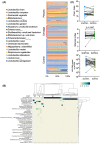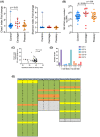Cervical pessary and cerclage placement for preterm birth prevention and cervicovaginal microbiome changes
- PMID: 36168933
- PMCID: PMC9812209
- DOI: 10.1111/aogs.14460
Cervical pessary and cerclage placement for preterm birth prevention and cervicovaginal microbiome changes
Abstract
Introduction: Our objective was to compare the vaginal microbiome in low-risk and high-risk pregnant women and to explore a potential association between vaginal microbiome and preterm birth.
Material and methods: A pilot, consecutive, longitudinal, multicenter study was conducted in pregnant women at 18-22 weeks of gestation. Participants were assigned to one of three groups: control (normal cervix), pessary (cervical length ≤25 mm) and cerclage (cervical length ≤25 mm or history of preterm birth). Analysis and comparison of vaginal microbiota as a primary outcome was performed at inclusion and at 30 weeks of gestation, along with a follow-up of pregnancy and perinatal outcomes. We assessed the vaginal microbiome of pregnant women presenting a short cervix with that of pregnant women having a normal cervix, and compared the vaginal microbiome of women with a short cervix before and after placement of a cervical pessary or a cervical cerclage.
Results: The microbiome of our control cohort was dominated by Lactobacillus crispatus and inners. Five community state types were identified and microbiome diversity did not change significantly over 10 weeks in controls. On the other hand, a short cervix was associated with a lower microbial load and higher microbial richness, and was not correlated with Lactobacillus relative abundance. After intervention, the cerclage group (n = 19) had a significant increase in microbial richness and a shift towards community state types driven by various bacterial species, including Lactobacillus mulieris, unidentified Bifidobacterium or Enterococcus. These changes were not significantly observed in the pessary (n = 26) and control (n = 35) groups. The cerclage group had more threatened preterm labor episodes and poorer outcomes than the control and pessary groups.
Conclusions: These findings indicate that a short cervix is associated with an altered vaginal microbiome community structure. The use of a cerclage for preterm birth prevention, as compared with a pessary, was associated with a microbial community harboring a relatively low abundance of Lactobacillus, with more threatened preterm labor episodes, and with poorer clinical outcomes.
Keywords: 16S rRNA gene; cerclage; cervical length; community state type; microbial community; microbial diversity; microbial richness; pessary; vaginal bacterial load.
© 2022 The Authors. Acta Obstetricia et Gynecologica Scandinavica published by John Wiley & Sons Ltd on behalf of Nordic Federation of Societies of Obstetrics and Gynecology (NFOG).
Conflict of interest statement
The authors have stated explicitly that there are no conflicts of interest in connection with this article.
Figures




References
-
- Hack M, Taylor HG, Klein N, Eiben R, Schatschneider C, Mercuri‐Minich N. School‐age outcomes in children with birth weights under 750 g. N Engl J Med. 1994;331:753‐759. - PubMed
-
- Hurley EG, DeFranco EA. Influence of paternal age on perinatal outcomes. Am J Obstet Gynecol. 2017;217:566.e1‐566.e6. - PubMed
-
- Paules C, Pueyo V, Marti E, et al. Threatened preterm labor is a risk factor for impaired cognitive development in early childhood. Am J Obstet Gynecol. 2017;216:157.e1‐157.e7. - PubMed
-
- Wallace JL, Aland KL, Blatt K, Moore E, Defranco EA. Modifying the risk of recurrent preterm birth: influence of trimester‐specific changes in smoking behaviors. Am J Obstet Gynecol. 2017;216:310.e1‐310.e8. - PubMed
Publication types
MeSH terms
LinkOut - more resources
Full Text Sources

